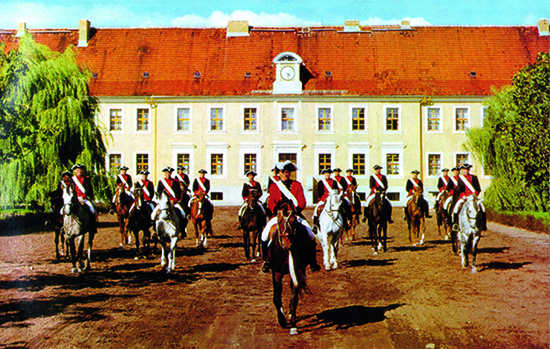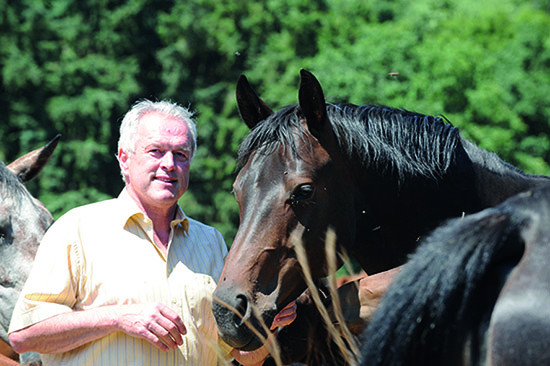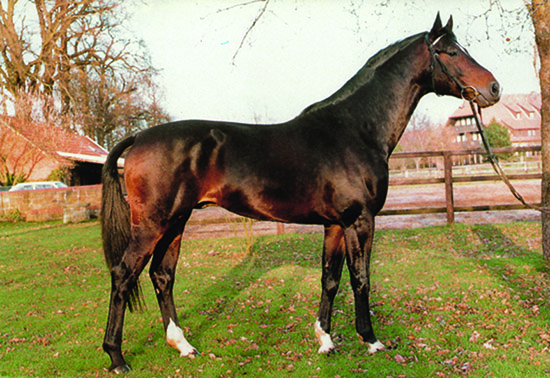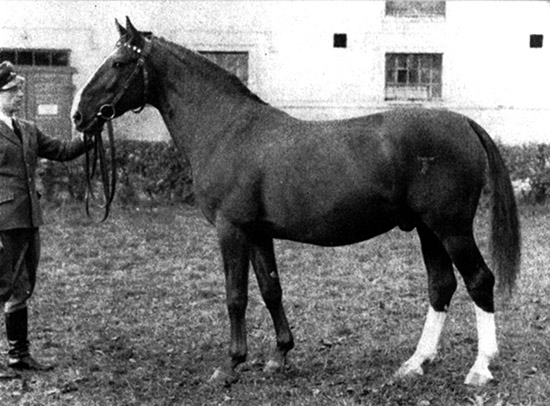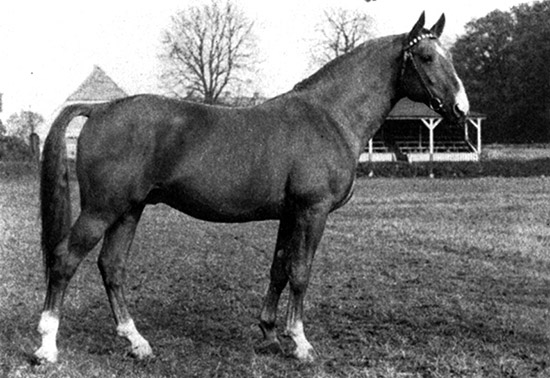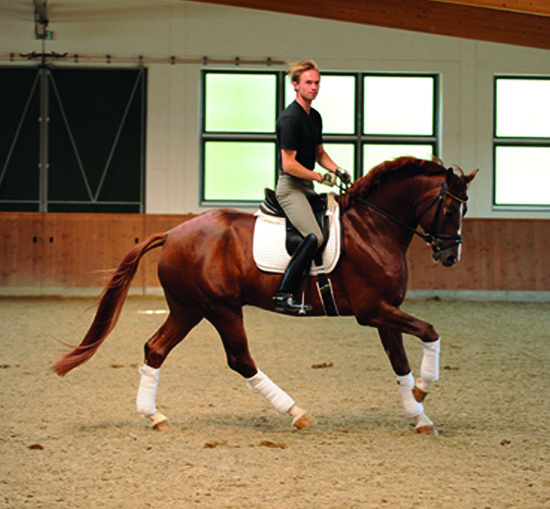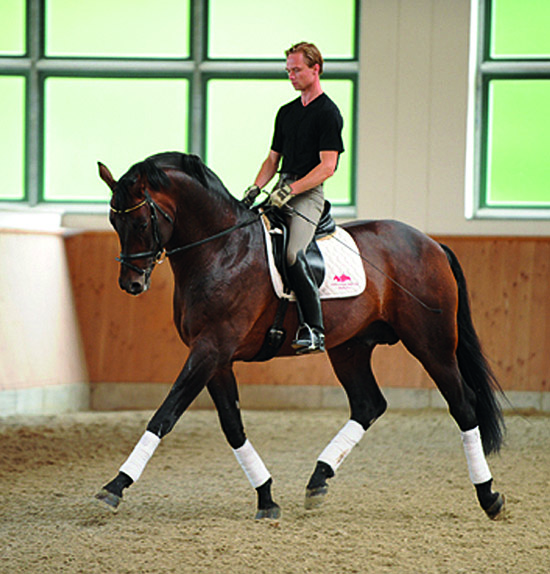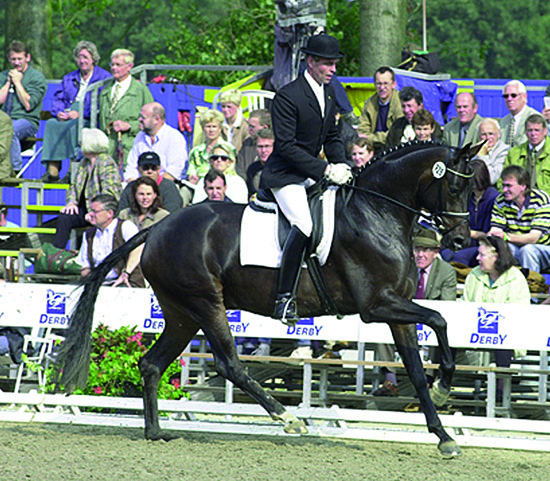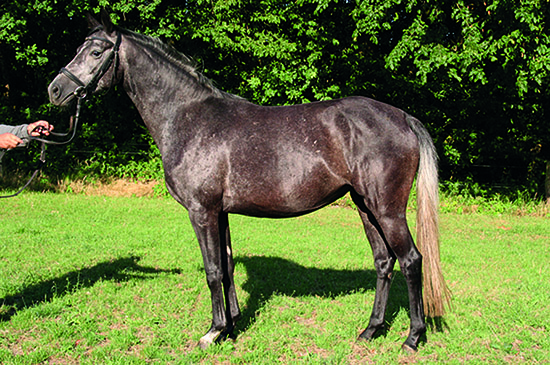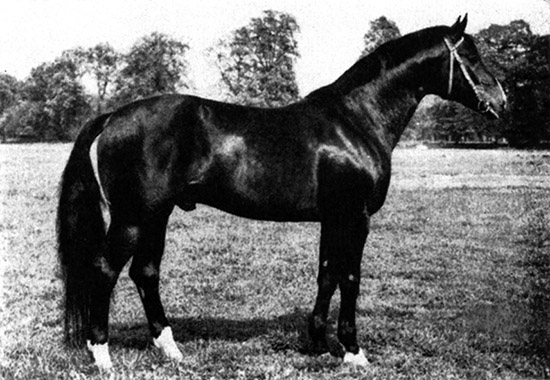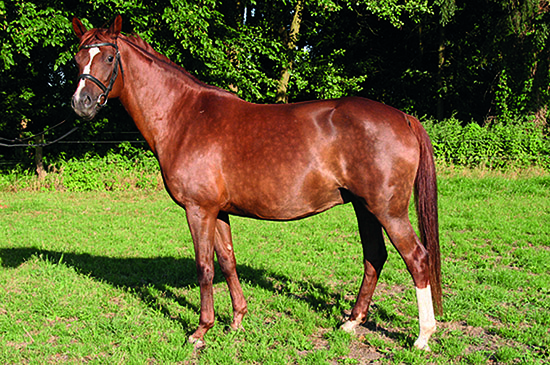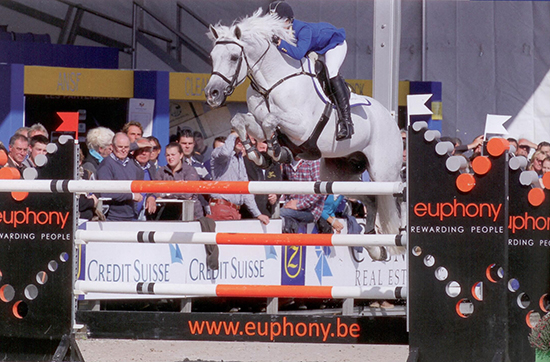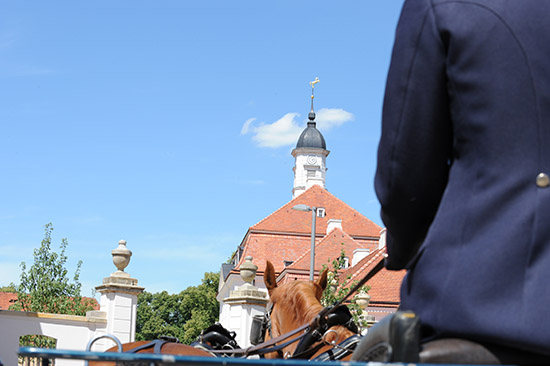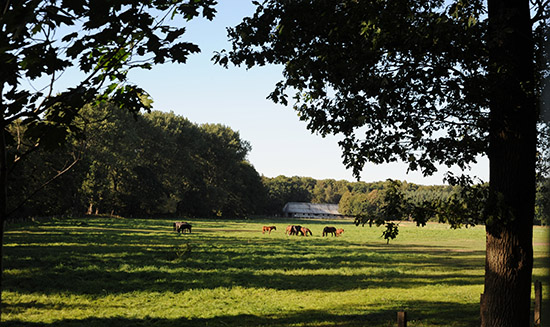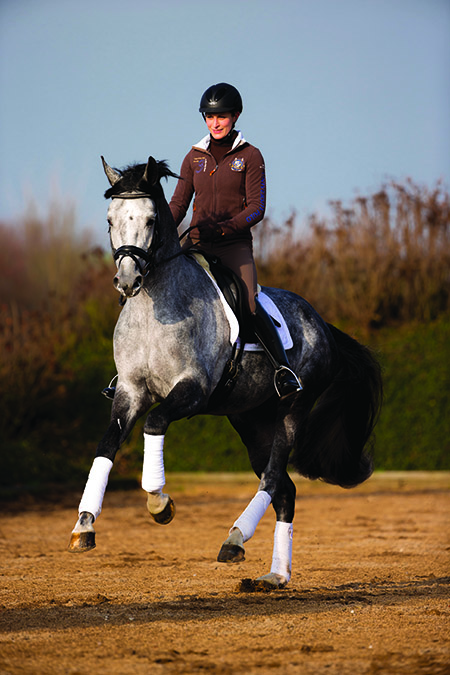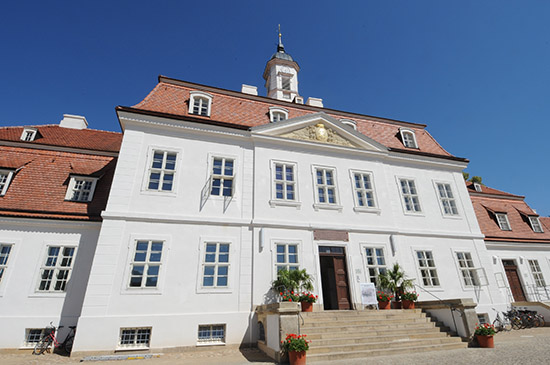Neustadt – something old, something new
It was just on twenty years ago when I first visited the historic Brandenburg Stud at Neustadt Dosse. Even though the Wall had just come down, and the two Germanys united in one, Neustadt was still the victim of the years of communist rule. Especially after coming from the ostentatious wealth of Hamburg, the area looked poor, run down and depressed.
Still there was no denying that the Stud itself was an impressive complex. My wife and I started laughing as we approached the main administration building, it had been erected in 1788 as our convict forefathers were making the slow journey from the old world to the new, to establish the colony that would become Australia.
Despite the isolation of the previous forty years, the Stud at Neustadt had several things going for it. One was a very fine – and elegant – mare band, largely influenced by Trakehner blood, some from the original main stud at Trakehnen, some from the Trakehners of Russia. There was an exciting young stallion, Brandenburger, of whom great things were expected…
It also had a young and visionary leader in Dr Jürgen Müller. You got the feeling that he was going to take every advantage of the new opportunities and that the future for his stud was bright.
Since then Dr Müller’s progress has not all been straightforward, there were a few unexpected twists of fate along the way, but when we re-visited in 2008 we found that Neustadt – with the influx of 40 million Euros from the European Community – was THE state-of-the-art state stud in Germany.
There are still a few buildings to be renovated but the original complex is very beautiful. Add to this a brilliant new indoor riding hall / sales complex / venue for concerts, and the weekend after our visit, the German version of the ‘schoolies’ end of the year breakup, a handful of indoor riding halls, lots of outdoor riding arenas, and hectares of rich farmland criss-crossed by riding tracks and carriage trails.
And that mare band? Well with the judicious addition of the best that Western Germany had to offer, it is even more beautiful than it was, and the stud is producing some genuinely exciting young horses – stars like Poetin, and her stallion brothers, Samba Hit 1 – 3, and the new kid on the block, the Bundeschampion, Quaterback.
Dr Müller and Poetin II
And Dr Müller has lost none of his vision or drive. At a time when the villages were being deserted with young people moving to other parts of Germany in search of work, the schools were threatened with closure. Solution? One hundred and fifty students from all over Germany, Europe, even one from South Africa, studying at the local school in the mornings, and working with either their own horses, or horses from the Stud in the afternoons.
Want to ride in Germany? Then you can come for a week of instruction on one of the Stud horses…
With a keen eye to the tourist industry, there are carriage rides around the vast hectares that make use of one of Europe’s most valuable collection of carriages – there is even a week long trip in a wonderful Mail Coach that travels through historic towns, stopping along the way.
Branderburger (Beach Boy / Wenderkreis)
And that young stallion? Well Brandenburger is no longer alive, but he played a key role in the making of the latest star at the Stud: Quaterback…
From being the youngest head of a state stud in Germany, appointed at the age of 29 – Dr Müller is now the most senior – and looks forward to celebrating 30 years at the Landstallmeister in 2009!
I asked Dr Müller if the history of the type of horse at Neustadt mirrored the development in the other major breeding areas of Germany – from a lighter riding type of horse at the end of the nineteenth century, to a heavier more agricultural type between the two World Wars, and then to a modern performance type, starting in the 50’s and continuing to the present day…
The older style – Ackermann (born 1948 – Akrobat / Flausch)
“I think we had the same history. We were founded in 1788 through the Prussian king, Friedrich Wilhelm II, and he needed horses for agriculture, for ceremony and for the Prussian cavalry. Now we only breed sport horses… for dressage, jumping and driving, and also for the pleasure rider. In the period of socialism from 1949 to 1989, we were a breeding centre here, and in the last 20 years we were the major export centre, sending sport horses to other countries.”
Another of the older style stallions, Fanfaron (born 1950, Fasching / Famos II)
“When I started in 1979, I looked all through the GDR, for horses that were good for dressage and jumping, and also for riding, and we built up the stud until we exported every year, 500 to 600 horses. Eighty percent went to Western Germany and the other 20% to Austria and Switzerland, some to The Netherlands and to the USA. Now we have in our stud, 320 horses and fifty stallions.”
At home, the stallion star, Quaterback
“From the middle of February to the middle of July, the stallions are at the fifteen stations in our breeding area. We also have two artificial insemination stations with 25 stallions, most of the stallions at the artificial insemination stations are also competing in jumping or dressage. These are the most successful stallions – the best example is Quaterback who was the winner of the Bundeschampionate in 2006. Last year he covered 647 mares all over the world. We exported frozen semen for 130 mares in the United States, and also for 50 mares to Australia.”
When you were part of East Germany, were you cut off from the development of the modern Warmblood in West Germany?
“In the 50’s it became possible for us to get a little bit from the Hanoverians and the Westfaliens, but this was three or four stallions no more. We also got some Trakehner stallions from the USSR and Poland. The basis of our breeding program was the local mare population – and the basis of that was Hanoverian and Mecklenburger and also Trakehner. In this area there were many Trakehner horses from the traditional association with the Court of Prussia and then after the Second World War, some Trakehner stallions came to our area. Our neighbour Mecklenburg stood before the Second World War, many Hanoverian stallions and from there we gained Hanoverian blood.”
When Germany was re-united and you have your choice of any bloodlines in the West, which did you go after?
“After 1990 it was very difficult for us. Many breeders who were organized in the agricultural collectives sold their horses – many very good mares were sold very cheaply to the West. The poor mares and horses of not such a good quality stayed here…”
“But we also have many young breeders who are interested in horse breeding and imported some interesting stallions in the 90’s. For the first time Weltmeyers, but not so many, also from Westfalia some good young horses. When we had enough money we bought very good stallions. About 70% of our mares are covered by our own stallions, and the rest with semen from very interesting stallions from other parts of Germany – from Mr Schockemöhle, from Mr Sprehe.”
“We have a very good situation that many young stallions come here to be tested in our Performance Station, it used to be 100 days, now 70 days, and we get the chance to see how good they are – in jumping or in dressage, and I can buy the semen from the stallions that we see are good before everyone else knows about them.”
Samba Hit – by Sandro Hit out of Poesie
So which has been the most successful stallion for you? Sandro Hit?
“Yes, Sandro Hit with Poetin, it was very successful. We now have five full brothers of Poetin, Samba Hit, I to V. And we have four Poetins, II to IV (The World Young Dressage horse champion, Poetin I sadly died after being sold to Paul Schockemöhle, then to Holland and finally to France). This year, Poetin III goes to the Bundeschampionate. She has won the Mares’ Performance Test, and the highest marks in the stud book inspection so we are very hopeful she will do well.”
Poetin at the Bundeschampionate, with Hans-Heinrich Meyer zu Strohen
The breeding of the Poetins, the Sambas and for that matter, Quaterback, is an example of just how crucially important those mare families are, and much of the modern day success at Neustadt, stems from a mare that used to work the fields…
“The founding mare, Pauline was born in 1937 and since then we have been very successful with this bloodline. After the Second World War, all our horses went out of the stud, on to a train and to Moscow. We had not a horse, not one coach… but Pauline was privately owned by a very successful local farmer. Gustav Condereit, who was the leader of the stud after the Second World War bought her for the stud. She was from an old family of horses from this area – agricultural horses, not riding horses. It was a long process, breeding the agricultural horses to the modern stallions but now we have much success with riding horses from this family.”
“We bought Pauline from the farmer in 1946, he used her in harness. She was by Charleton, a Brandenburger with a little part of Trakehner. Her daughter Palette was born in 1949, by Fernab, a grandson of Feiner Kerl. Palette, bred to another Hanoverian, Duo, a son of Duellant, produced Palmira in 1959 and in 1968, she foaled Pollick II by Ipikur – a stallion from Russia. This stallion was travelling with a circus, he was a very nice stallion, chestnut, and my predecessor bought him. He was a good mover and he made a very nice show in the circus. Panik was also a very good mare, very good performance mare. She was bred to Adept who was imported from Hannover, he was by Archimedes, a son of Abglanz. He was a very nice bay stallion, good mover – not so good in the legs, but a very nice head. He produced many licensed stallions and good mares for us. With Panik, he produced Parabel I and Parabel II and they founded a line for us.”
“Parabel I was bred to Frühlingsbote, he was a stallion from Westfalia, by Frühlingsball, and the dam sire was Damhirsch. That produced Pamina (a very good harness mare who was part of the 20 horse coaching team) who when bred to Sandro Hit, produced Pirouette in 1998. She was bred to Exposé, and produced Philharmonie in 2004.”
Philharmonie was my personal favorite, the most exquisite dark grey filly, she stood out, even in a mare band with so many pretty horses as the one at Neustadt…
Sekurit from the Semper Idem line…
“The other Parabel line, the one from Parabel II (also a daughter of Adept, a good coach mare, but also a good riding mare) begins with Sekurit from the Semper Idem line crossed with Duellant – on both sides of his pedigree, the same cross, grandsons of Senator out of grand-daughters of Duellant. This produced Parabiose in 1984 – this mare was bred to Gotland who was by the Gotthard son, Goldstein (out of a Steinpilz mare) out of a Pik König / Ferdinand mare, and produced Primadonna.”
Primadonna’s grand-daughter, Passionata…
And Primadonna leads to both the Poetins and Quaterback…
“Primadonna is one of our best mares. She died in April 2008, after the birth of her last foal, Poesie III. Poesie I bred to Diamond Hit, produced Piccola in 2001 – and Piccola has adopted the foal, Poesie III, after Primadonna’s death, and she is raising it with her own foal by Lord Fantastic.”
It was with the Hanoverian stallion, Brentano II (a son of the dressage sire, Bolero) that Primadonna produced Poesie, who in turn produced a series of foals that will go down in history:
“Poesie I, was bred to Brandenburg, an Oldenburg stallion by the Dutch stallion, Beach Boy, who was by the Anglo-Arab, Zeus, out of a Hanoverian mare by Wendekreis, to produce Passionata in 1996, and Passionata bred to Quaterman, produced Quaterback. Quaterman is a product of Quando-Quando’s time at Neustadt and he is out of a mare by the Holsteiner, Roccodero (by Rocco – this is not the licensing winner, Rocadero by Ronald)”
And of course, bred to Sandro Hit, Poesie produced the Poetins and the Samba Hits…
And you kept breeding the Poesies to Sandro Hit?
“Why not? When I sold Poetin I to Mr Schockemöhle, then part of the agreement was that for the lifetime of Poesie I, we can cover her with semen of Sandro Hit for free.”
Have you got a separate dressage and jumping lines – or do you breed for an all-round horse?
“I have specialised in the stud breeding dressage horses – 70% of the foals from our mares are for dressage and 30% for jumping.”
There seems to be a feeling now that for dressage we need a little jumping blood, and with Quaterback, there is quite a lot of jumping blood…
“When I look at the stallions that go through the performance test in our testing station, the stallions that are the best are not only specialised for dressage, the best are good in dressage but also a little bit jumping. Sandro Hit had a very bad performance test, and yet his offspring are very good for dressage, not for jumping and they are very good movers – a little bit crazy in the head but very good movers. I was one of the first to breed with Sandro Hit – Poetin was the first really great foal by him, and then everyone wanted to breed to Sandro Hit.”
If someone had said to you, we are going to get a French showjumper and breed dressage horses – you would have said, you are crazy, yet, Quattro B is a successful sire of dressage horses…
“But Quattro himself is a very good mover, and Quando Quando is out of a mare by Akzent by Absatz. Akzent was also a good mover, and we leased Quando Quando for three years and he was the winner in the performance test. He was a good mover, but he could also jump.”
Levisto – getting in early
It’s a growing trend for the State Studs to lease stallions that would be too expensive to buy?
“Exactly, I also leased for some years the stallion, Levisto – he was too expensive for me to buy. Levisto was the reserve champion in Holstein in jumping in 1999 – I leased him for four years, and he covered just on 170 mares per year, so we have many good jumping horses in our area. The owner of Levisto sold him for over one million euros to Alfonso Romo of La Silla stud in Mexico, then he was sold back to Europe, to Leon Melchior of Zangersheide, and now he is being ridden very successfully by his daughter, Judy-Ann. He was a very nice stallion, not so tall, but a very good mover. He was in second place for movement, and the winner for jumping ability in the performance test. The offspring from him are better jumping horses than dressage horses.”
What are the most popular stallions in your breeding area?
“One of the most popular stallions is Convoi – by Contender. He was one of the first by Contender, at that stage we did not know who Contender was, and we bought Convoi in Hanover in 1992, out of a Black Sky mare – Contender needs Thoroughbred to produce a modern type. Convoi is a premium stallion and breeds many mares. In his performance test he scored 136 points, in second place out of 40 stallions, and he won the dressage section.”
“Samba Hit I covered many mares. The mares who work best with him are mares who are very correct in the legs and also when they have a little bit of blood from the Thoroughbred or the Trakehner.”
You’ve even got a Thoroughbred by Lauries Crusador?
“This is the only one in Germany – a Thoroughbred son of Lauries, and at a big show last year, he was second of the Thoroughbred stallions. He has a very nice character… he has a very nice walk and a very good canter, the trot is okay. He does the 30 day test in autumn.”
And Quaterback?
“He gets the most mares, this year I think 600. When he has mares with very nice heads, then he makes very nice fillies – and the colour of the mare, is the colour of the filly. He does not only make chestnut horses, he also makes many brown horses from brown mares. All his offspring are very good movers. I was at a big filly show last weekend, and in the final, there were 16 fillies, and eight were from Quaterback, and they were the winners.”
And the stud is supported by the Government?
“By the government. A foundation was established in 2001 which made it possible to get funding from the European Commission, altogether 40,000,000 euros – 80% from the Europeans, and 20% our own. From this we have all the renovations and the new buildings. We must preserve for the people coming after us, this world cultural heritage.”
Do you look to tourism to support the Stud in the future?
“Rural development is – apart from breeding – our main objective, therefore we do focus on tourism even more in the future. We have now a marketing director who speaks four languages, and we also enhance our public relation activities, so we hope that more people from Germany and from all over the world, will visit our stud. Very many people come to the four Stallion Parades – 30,000 per year. This year for the first time, we make the Stallion Parade in the evening along with fireworks.”
You recently took part in a meeting of historic studs in Lipica?
“It was a very interesting meeting. We had 22 representatives from all over Europe: France, Austria, Switzerland, Germany, Poland, Russia, Hungary, Czechoslovakia, Slovakia and Romania. Twenty two studs, and all the studs have little problems with the money but all of them have programs to help them survive in the future. Hopefully we can get together and preserve the cultural heritage of our studs.”
UPDATE – In 2014, we once again visited Dr Müller to record this interview:
When you started out as the director here at Neustadt-Dosse, you were the youngest landstallmeister in Germany, now I believe you are the most senior, and your stud has gone from one of the poorest to one of the most magnificent…
“I started my career here in 1975, I was 29 years old. We were at this time in the GDR, the centre for horse exporting. In one year we sold between 500 and 600 horses from three to eight years old, many of them, about 80% went to the ‘other’ part of Germany. Now we have a new time, we have taken some new stallions, again from the other part of Germany, and we have been very successful. I think perhaps our greatest success was winning the World Championships with Poetin, then she was sold for €2,500,000 to Mr Schockemöhle, that was another success for us. Our stud is now very respected in Germany and internationally.”
“It was turned into a foundation in 2001 so it was possible to receive a grant from the European Community to make possible re-construction and new buildings. Over the last five years, we have used €40,000,000 – it has been a very nice time.”
Where-ever I go in Europe, I hear the same thing, breeding is down, is this affecting you?
“For sure, but for us not so much. We have talked with the ten state studs of Germany, and all the state studs find the horse breeding and the coverings of the mares, is going down. For us, it was not so bad, we have very good stallions – Quaterback is covering over 200 mares, and now Belantis, our new champion, is doing the same. I hope that the time when horse breeding goes down is a little bit over, and in the next years we see some growth. In the last year, we sold many horses into Germany, also a very fine stallion to Russia for a good price, and also one very expensive horse to the United States – it was a very talented dressage horse.”
“Quaterback is now eleven years old, and he is now the sire of 56 stallion sons, licensed all over the world. The quality from him is very good – in trot and very good in canter. When he won at the Bundeschampionate in 2006, the judges said they should have given him 12 for the canter, we are sorry that it is only possible to give 10. He has very good foals, we send semen all over the world. That is our bank, and we wish him a long life so that we can take a little bit more money.”
Are there certain mares that he is best with?
“Now that he is eleven, we know what is the best mare for him, the longer the stallion lives, the better you know what he needs. He needs some blood from the Thoroughbred and also from the Trakehner line. He needs very solid mares who are clear in the head and have a very good character – all his offspring have very good movement, for example last year in the Bundeschampionate, in the five-year-old class, there were five young horses by him. They are light to ride, but the rider must be good, his progeny are no sleepy heads.”
Your stud is a little different, you have many mares of your own, does that make it easier for you?
“I think so. We have 35 mares on our farm, and we breed with them – but horse breeding is very expensive, and for us it is not so easy to explain to the politicians that we need to breed these horses. That is traditional for Neustadt, and many people come to visit us, last year there were 50/60,000 visitors – it is a little bit world heritage. We were founded in 1778… and it is very good for our area. We give thanks to the Prussian King that he made these very fine buildings, the stud has been breeding for 225 years.”
Belantis, the new star
Can you tell me a little bit about the mother line of Belantis – is this one of your traditional mare families?
“This a very traditional line. The first mare was Paulina, we bred with this line for many years, she was born in 1937 – it is our well-known ‘P’ line that produced Poetin and Quaterback. The grandfather is a Holstein stallion, Expo’se, and this stallion was ridden very well by Mr Flamm (Christian Flamm who was stud rider), successful to Intermediate I & II. So we have a little bit of jumping in this mother line, and I think that is very successful.”
“Last year out of Philharmonie, the mother of Belantis, we bred a very nice filly, by Don Juan de Hus (Jazz / Krack C).”
You were one of the first to use Sandro Hit, and Poetin was the first really famous foal of Sandro Hit, looking at it now, was Sandro Hit a good thing, or a bad thing?
“Poetin was born in 1997, and at this time, I think Sandro Hit was a good thing, but now Sandro Hit is in the second and third generation, and I think that is enough – I don’t think we need him now. The offspring are difficult to ride, but we have a very good mother line. Sandro Hit was a bit crazy, but we have a filter, our mother line is very good in its temperament… At the time Sandro Hit was a good combination with our mares, but that was ten years ago, and now we have other good stallions, and we need horses with a good rideability, three good gaits – especially walk. And with Sandro Hit we never have a good walk!”
Which stallions are you using in your jumping horse program now?
“Now we take some stallions from France. Two years ago, we bought a stallion by Diarado, from the Oldenburg Jumping studbook – Discar, out of a Caretino grand-daughter. He was the reserve champion in the licensing, and reserve champion in the 30 day test. Discar covered many mares in our area, this year we have the first foals and we are pleased. He is a very good jumper. We also bought at the Munich licensing, a very nice stallion by Flipper d’Elle, out of a Candilo / Landgraf mare – Flipper d’Elle is from the Ibrahim line, a very good stallion.”
“We also have used Mylord Cathargo, and yesterday we had one filly born, out of an Abgar mare, and we have another Abgar mare in foal to Mylord, and we hope that it will be a colt. We need this blood in our stallion lines.”
“We need interesting stallions for our future.”
What do you think the French blood will add to your program?
“I think we need the French blood, but pure French blood is not so nice to use. I take the French blood on the father line, with German blood on the mother line, that is better. For me, the French horses are not so nice in the head, sorry, and most breeders want a good head. I think with a good mother line, Holstein or German Sport horse from our area, then it is possible to use the French stallions.”
Have you used Baloubet de Rouet?
“Yes, and we have bred a good stallion by his son, Balou de Rouet, but we had to sell him for very much money to Mr Sprehe, and he is now jumping with his son.”
In dressage where do you see the next bloodline coming from?
“It is a very difficult question. Right now in Western Europe, there are very successful dressage horses from Holland, and also from Denmark. The lines are coming out of Germany, but they have a very good system for selection through the performance test, and importantly, they use the x-rays in the selection. We need this also in our area. So I think we can use a little bit the blood from The Netherlands.”
From Jazz?
“Jazz a little bit. I have this year, two stallions where the father lines are from The Netherlands. One is Vis a Vis, he is by Vitalis, by Vivaldi, and out of a Florestan mare. The next is Bombastic, he is by Boston who is Jazz / Flemmingh out of a grand-daughter of De Niro.”
Is this a difficult line to deal with, the Jazz horses have the reputation of being a little crazy?
“I think we must be the same as with the French, the father line from The Netherlands, and the mother line from Germany, so in the next generation we have 25% from Jazz or from Flemmingh…
How much longer will you stay being the director here at Neustadt?
“One year, then I am 65 and now I must help my manager, and the director who comes after me make the transition. In the last year I have been doing quite a lot of judging, especially for the Arab horses – I was last year in Kuwait, in Qatar, Iran – it was a very nice time.”
I am sure it will be a very nice time, but I’ll certainly miss the opportunity to drop into Neustadt and spend time with such a knowledgeable and friendly director…


